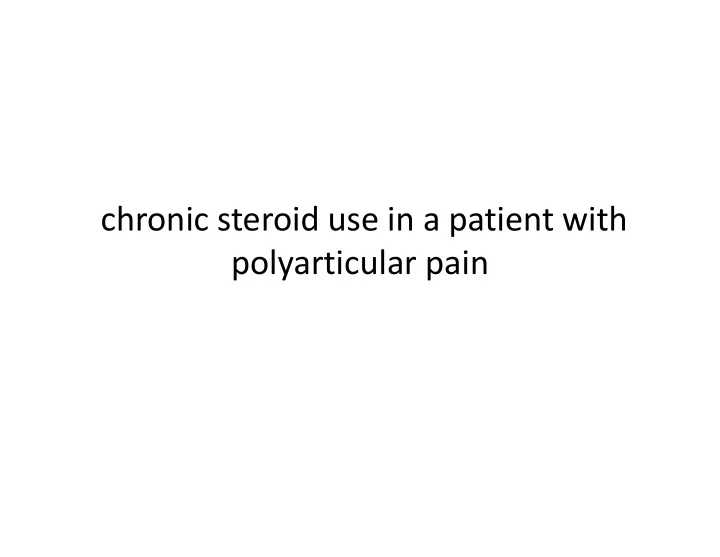

chronic steroid use in a patient with polyarticular pain
E.W 47 yrs, female, Nairobi DOA: 6/1/11 DOD: 18/1/11 Presenting complaints: Facial swelling* 3 Days Generalised body weakness*1 day
Facial swelling was located in the right maxillary region insidious in onset, rapidly increased in size, eventually discharged frank pus. Associated with sharp pain and fever
Recurrent episode Having had similar swelling on and off over past 2 years which started after a tooth extraction done at a dental clinic in Eastlands treated several times with antibiotics without improvement, I&D, biopsy was being taken, no results available
Generalised body weakness was sudden in onset, preceeded by extreme fatigue , could not walk without support. Ass. with dizziness, nausea No vomiting No dyspnea , exertional chest pain
1994 ‐ pain in the wrist and knee joints ‐ symmetrical The joint pain was dull, constant, aggrevated by cold. No relieving factors Associated with morning joint stiffness which lasted approximately 2 hours.
No joint swelling. No joint deformities No hx of numbness, paresthesia or muscle weakness No fhx of rheumatic diseases
She sought medical assistance from a pharmacy in Kariobangi ‐ prednisolone 10mg bd Continued to self medicate with the same drug and dosage till Dec 2010. Dec 2010 doctor who immediately stopped the drugs and she got a new prescription of seven drugs, not sure which ones?
6 years of taking prednisone ‐ excess weight gain ‐ 70 ‐ >100kg, especially on the abdomen, face and neck mood lability, muscle weakness(raising from sitting position was difficult and lifting her shoulders), epigastric pain.
June 2010 she also reports having increased BP, though not started on antihypertensives. RBS has consistently being normal She had no hirsutism, no easy bruising and has regular menstrual cycle No back pain or bone pains
Fshx: retired hotelier, married, six children, lives in Dandora. Education level ‐ class seven leaver No fhx of DM, hypertension
On examination Sick looking, cushingoid appearance,mild pitting pedal edema swelling on the maxillary region 3*4cm, discharging frank pus, erythematous, warm, tender, flactuant not dehydrated, no lymphadenopathy, no oral ulcers. No skin lesions noted
Wt 106 kg Ht157cm BMI 43kg/m² • BP: 86/46mmhg • PR: 110/MIN • RR: 24/MIN • Temperature: 37.4
Musculoskeletal examination: no subcutaneous nodules, No deformities Knee and wrist joint examination: not swollen, not erythematous, not warm, full range of movement Eye exam: no cataracts, fundoscopy ‐ normal
Diagnostic formulation • Acute adrenal crisis precipitated by infection • Acute adrenal insufficiency due to rapid withdrawal of steroids in a patient with HPA axis suppression due to chronic exogenous steroid use • Other complications of chronic steroid use : Cushing’s syndrome, reduced immunity • Undiagnosed polyarticular pain
Investigations 6/1/11 ref K+ 5.0 3.5 ‐ 4.9 NA 134.3 135 ‐ 140 chloride 96.7 95 ‐ 103 urea 8.6 4.7 ‐ 8.9 creatinine 106 60 ‐ 120 RBS: 23.3 mmol/l Urinalysis: glucosuria ++, no ketonuria, no microalbuminuria
• FBC WBC 12.5 No differential counts done HB: 11.3 g/dl MCV 88.5 fl Plts 148 ESR: 45mm/hr • Serum cortisol ‐ 9µg/dl • Fasting Lipid Profile ‐ total chol 5.94(5.1), HDL 1.22(1.2), LDL 2.97(3.3) TG 3.84(1.7)
• LFTs, Calcium, ALP ‐ Normal • Serum uric acid levels: Normal • Rhematoid factor: Negative • VDRL: Negative • Anti DsDNA, anti ‐ CCP, ANA, ‐ Negative • Thyroid function tests ‐ normal
• ECG: Sinus tachycardia • X ‐ ray of the maxillary bone ‐ normal
Ward progress 7/1 8/1 9/1 10/1 11/1 12/1 13/1 14/1 15/1 16/1 FBS 14.1 12 11.1 12.2 10 4.0 9.0 7.0 7.2 6.9
MANAGEMENT USA: 0.5% of the general population, 1.75% of patients >55years 56 ‐ 68% of patients with rheumatoid athritis 2 major complications of chronic glucocorticoid use: ‐ HPA axis suppression ‐ cushings syndrome Identifying pts with HPA suppression: HPA suppression likely: Prednisone 20mg /day>3/52 Patients with clinical cushing’s syndrome
• HPA suppression unlikely: Any dose of glucocorticoid for less than 3 weeks Patients on alternate ‐ day glucocorticoid therapy • Intermediate/uncertain risk: 10 ‐ 20mg/day >3wks
• Unlikely suppressed: weaned as appropriate for the underlying disease • Intermediate ‐ gradual reduction. If abrupt discontinuation is being considered test responsiveness of the adrenal with ACTH stimulation test(cosyntropin).
• Likely suppressed: treated as having secondary adrenal insufficiency. Steroids should be gradually tapered Two approaches to tapering steroids: Relative stable decrement of 10 ‐ 20% every 1 ‐ 2 wks 2.5 mg every 2 wks ‐ 8 wks
Repeated morning cortisol measurements: morning plasma cortisol measurements every 2 ‐ 4 wks. Taper 2.5mg/wk Steroid could be discontinued when plasma cortisol concentration is greater than 10µg/dl
Mgt of acute adrenal crisis • Volume replacement • Glucorticoid supplementation ‐ hydrocortisone 100mg iv stat then 10mg/hr; no need for mineralocorticoid – If dexamathasone add fludrocortisone 2mg stat then 0.5mg od, increased salt intake • Treat precipitating factor ‐ I&D, antibiotics • Once pt stable reintroduce previous steroid and gradually taper
Mgt of cushings syndrome • Hypertension ‐ 6/1/11 7/1/11 9/1/11 10/1/11 11/1/11 13/1/11 15/1/11 17/1/11 18/1/11 86/46 120/90 140/90 160/100 160/110 150/110 140/100 130/95 115/80 tx as essential HTN blocking mineralocorticoid activity with spironolactone may be particularly effective HCTZ 25Mg od, Losartas 50mg od Easier to control and may entirely disappear when cushing’s syn is treated
• Glucose intolerance Tx like type 2 DM easier to control and may completely remit if the hypercortisolism is reversed Soluble insulin 10mg iv tds, mixtard 30/70 24iu am, 12iu pm
• Cushingoid habitus ‐ fat redistribution occurs over months, healthy lifestyle ‐ exercises, diet • Muscle wasting and weakness ‐ high protein diet and exercises may improve muscle wasting and increase strength
• Reduced immunity ‐ pts predisposed to common and opportunistic infxns Non ‐ healing abscess ‐ osteomyelitis/atypical infxns including mycobacteria/ malignancy • Additional tx: DVT prophylaxis, PPI, Statin • Polyarticular pain ‐ follow up in the rheumatology clinic
• thankyou
Recommend
More recommend